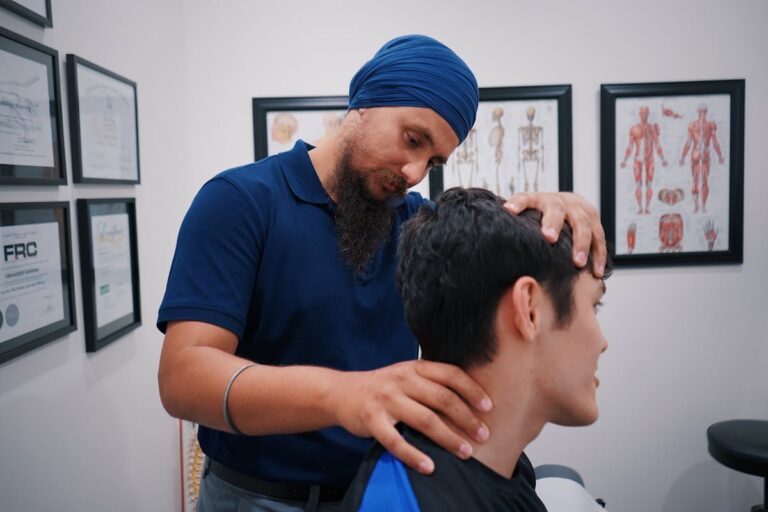Is Chiropractic Care Safe for Seniors?
Chiropractic care, a popular alternative treatment for musculoskeletal issues, raises questions about its safety for seniors due to age-related changes like fragile bones and joint issues. Nevertheless, when performed by licensed professionals using gentle, tailored techniques, this practice is generally safe and beneficial for older adults. Research indicates positive outcomes in mobility and pain reduction, yet understanding potential risks and personalized care plans is essential for informed decision-making.
Understanding Chiropractic Care
Chiropractic care, a branch of complementary medicine, focuses on diagnosing and treating musculoskeletal disorders, primarily through manual adjustments and manipulations of the spine. It aims to improve spinal alignment, alleviate pain, and enhance overall physical function. Despite its growing acceptance, various chiropractic myths persist, particularly among seniors. A common senior misconception is the belief that chiropractic care is unsafe for older adults due to their fragile bones. However, evidence-based research indicates that when conducted by licensed professionals, chiropractic treatment is generally safe and can be beneficial for seniors. Techniques are often adapted to accommodate age-related changes, ensuring tailored interventions. It is critical to dispel these misconceptions, enabling seniors to make informed decisions about their healthcare options.
The Aging Body: Unique Considerations for Seniors
Recognizing the unique physiological changes that accompany aging is vital when considering healthcare interventions for seniors, including chiropractic care. The aging process involves significant body changes, such as decreased bone density, reduced muscle mass, and joint stiffness. These alterations can affect mobility and increase the risk of injury. Moreover, seniors often experience changes in balance and coordination, making them more susceptible to falls. The spine, a common focus in chiropractic care, may exhibit degenerative changes such as osteoarthritis and disc degeneration, which require careful consideration in treatment planning. Understanding these factors is essential for tailoring chiropractic interventions to guarantee they are both safe and effective. Evidence-based approaches must account for these age-related changes to optimize care for the elderly population.
Common Chiropractic Techniques for Seniors
Many chiropractic techniques have been adapted to address the specific needs of seniors, ensuring that treatments are both safe and effective. Gentle adjustments are frequently employed, minimizing the risk of injury to aging bones and tissues. These adjustments are tailored to improve spinal alignment without exerting undue force, fostering a supportive environment for the body’s natural healing processes. Techniques such as the Activator Method use a small handheld instrument to deliver precise, controlled impulses, enhancing spinal alignment and reducing discomfort. Chiropractors may also utilize the flexion-distraction technique, a method involving a specialized table to gently stretch and decompress the spine. This approach is particularly beneficial for alleviating pressure on spinal discs, promoting overall spinal health in the senior population.
Potential Benefits of Chiropractic Care for the Elderly
Utilizing techniques specifically adapted for seniors not only enhances the safety and effectiveness of chiropractic care but also lays the groundwork for numerous potential benefits. Primarily, elderly individuals may experience improved mobility and reduced pain, which are frequently targeted outcomes of chiropractic interventions. Such care can potentially alleviate discomfort associated with arthritis and other age-related conditions. Additionally, addressing chiropractic misconceptions through senior education can empower older adults to make informed decisions about their health. Studies suggest chiropractic care may also contribute to better overall function, thereby improving the quality of life. By integrating chiropractic care into their healthcare regimen, seniors might benefit from a holistic approach that prioritizes their unique physiological needs and encourages proactive health management.
Risks and Safety Concerns for Senior Patients
While chiropractic care for seniors can offer numerous benefits, it is essential to take into account the specific risks and safety concerns associated with this demographic. Age-related conditions such as osteoporosis and arthritis can pose senior contraindications, increasing the potential for adverse effects during spinal manipulation. It is essential to differentiate between chiropractic misconceptions and evidence-based concerns to guarantee appropriate care. Skepticism often arises from misconceptions regarding the force used during adjustments, which can be modified for elderly patients. Practitioners must conduct thorough assessments to identify any contraindications and tailor treatments accordingly. Additionally, communication between chiropractors and other healthcare providers is crucial to avoid complications. A cautious, individualized approach can effectively minimize risks and enhance safety for senior chiropractic patients.
Research Findings on Chiropractic Care for Seniors
Recent research on chiropractic care for seniors underscores its potential benefits while highlighting the need for a tailored approach due to age-specific conditions. Senior studies have demonstrated chiropractic efficacy in alleviating musculoskeletal pain, improving mobility, and enhancing overall quality of life in older adults. A systematic review reveals that seniors undergoing chiropractic treatment often experience significant reductions in back and joint pain. Additionally, these interventions may contribute to improved balance and reduced risk of falls. However, studies emphasize that practitioners must consider individual health status, comorbidities, and potential contraindications when devising treatment plans for this demographic. While the evidence supports positive outcomes, the necessity for more thorough, large-scale clinical trials remains to substantiate the long-term safety and effectiveness of chiropractic care in the elderly population.
Consulting With Healthcare Providers
How can seniors guarantee they are receiving the best chiropractic care tailored to their unique needs? The consultation importance cannot be overstated in achieving this goal. Seniors should engage in healthcare collaboration by consulting with their primary care physicians and specialists before beginning chiropractic treatment. This multidisciplinary approach guarantees all aspects of the senior’s health are considered, minimizing risks and maximizing therapeutic benefits. Evidence suggests that when healthcare providers work in tandem, they can better address age-related issues such as osteoporosis and arthritis, which may impact chiropractic care. By fostering open communication among medical professionals, seniors can develop a more thorough understanding of their treatment options, guaranteeing that chiropractic interventions align with their overall health objectives and safety requirements.
Personalizing Chiropractic Care Plans for Seniors
Personalizing chiropractic care for seniors requires a thorough assessment of individual health needs to guarantee that each treatment plan is tailored appropriately. Techniques must be adapted to prioritize comfort and address the unique physiological changes associated with aging. Additionally, ongoing monitoring of treatment progress is essential to adjust interventions as needed and enhance overall outcomes.
Assessing Individual Health Needs
When considering chiropractic care for seniors, understanding the unique health needs of each individual is paramount. Tailoring care requires extensive individual assessments and thorough health evaluations to guarantee that the treatment plan aligns with the patient’s specific conditions. Seniors often face unique health challenges, such as osteoporosis, arthritis, or previous surgeries, which necessitate a careful examination of their musculoskeletal health. Evidence-based approaches involve evaluating medical history, current medications, and overall physical health to identify potential risks and benefits of chiropractic interventions. By conducting detailed assessments, practitioners can effectively personalize care plans, optimizing therapeutic outcomes while minimizing potential adverse effects. This meticulous approach underscores the importance of individualized care, ensuring that chiropractic interventions are both safe and beneficial for the aging population.
Adapting Techniques for Comfort
Why is it essential to adapt chiropractic techniques for seniors? With aging comes increased susceptibility to musculoskeletal disorders, necessitating tailored chiropractic care. Gentle adjustments are vital, ensuring the spine and joints are manipulated with minimal force to prevent injury. Evidence suggests that these softer techniques can effectively alleviate pain, improve mobility, and enhance overall well-being in older adults. Comfort techniques, such as the use of supportive cushions and specially designed tables, further enhance treatment by accommodating age-related physical limitations. By personalizing chiropractic care plans with these considerations, practitioners can offer safer, more effective interventions for seniors. This approach not only respects the unique physiological needs of aging bodies but also contributes to a higher quality of life.
Monitoring Treatment Progress
As chiropractic care adapts to accommodate the physical needs of seniors, the focus naturally shifts towards the meticulous monitoring of treatment progress. Effective treatment evaluation is essential for guaranteeing the safety and efficacy of chiropractic interventions in this demographic. Progress tracking allows practitioners to personalize care plans, considering the unique health profiles of elderly patients. Regular assessments, incorporating both subjective feedback and objective measures, facilitate timely adjustments to therapeutic strategies. Evidence-based methodologies underscore the importance of data-driven decisions to optimize outcomes. Chiropractors employ tools such as range of motion tests and pain scales to quantify improvements or identify areas needing modification. This systematic approach not only enhances patient satisfaction but also guarantees that seniors receive tailored care, aligning with their evolving health needs.
Real-Life Experiences: Seniors’ Testimonials
In exploring the efficacy of chiropractic care for seniors, testimonials provide valuable insights into its impact on pain relief, mobility improvement, and overall wellness. Many seniors report significant reductions in chronic pain, allowing for enhanced physical function and quality of life. These accounts are supported by clinical evidence, underscoring the potential of chiropractic interventions to contribute positively to seniors’ health outcomes.
Pain Relief Stories
For many seniors, chiropractic care emerges as a beacon of hope, offering relief where traditional methods have fallen short. In the area of pain management, senior experiences reveal compelling stories of alleviation from chronic discomfort. Testimonials often highlight how chiropractic interventions have successfully addressed issues such as lower back pain, arthritis, and sciatica. These real-life accounts underscore the personalized nature of chiropractic treatment, which adapts techniques to meet the unique needs of the elderly. Evidence supports that targeted spinal adjustments can enhance pain relief, promoting better quality of life. Professionals emphasize that, when executed by qualified chiropractors, these interventions are not only safe but also effective, providing seniors with a non-invasive alternative to pharmacological pain management strategies.
Mobility Improvement Accounts
Numerous seniors have reported significant improvements in mobility following chiropractic care, attributing their increased range of motion and flexibility to these personalized interventions. For many, such care has addressed mobility challenges that are often a natural part of aging. Testimonials frequently highlight how chiropractic adjustments have contributed to balance improvement, an essential factor in reducing fall risk among the elderly. Evidence-based approaches within chiropractic care often focus on spinal alignment and joint health, which are vital for maintaining physical functionality. Seniors have noted that ongoing sessions help sustain their newfound mobility, enabling them to engage more fully in daily activities. These accounts underscore the potential of chiropractic care to enhance life quality by mitigating impediments associated with aging.
Overall Wellness Benefits
Chiropractic care extends beyond mobility improvements, offering numerous overall wellness benefits that seniors have repeatedly emphasized in their testimonials. These accounts highlight a holistic approach to health, focusing not only on alleviating pain but also on enhancing general well-being. Seniors frequently report reductions in chronic discomfort, increased energy levels, and improved sleep quality. The preventive care aspect of chiropractic treatment is particularly underscored, as many seniors note a decrease in the frequency of age-related ailments. By addressing the root causes of health issues, rather than merely treating symptoms, chiropractic care supports long-term health. Testimonials often mention a strengthened immune response and a heightened sense of balance and coordination, contributing to an overall enhanced quality of life for seniors.
Frequently Asked Questions
Can Chiropractic Care Improve Sleep Quality for Seniors?
Chiropractic care may address sleep disturbances in seniors by improving spinal alignment. Research suggests that proper spinal health can enhance overall well-being, potentially leading to better sleep quality. However, individual results can vary, necessitating personalized assessment.
Are There Insurance Plans That Cover Chiropractic Treatments for Seniors?
Insurance coverage for chiropractic treatments varies among plans, with Medicare typically offering limited options. Seniors should review their policies to understand available treatment options, ensuring thorough care while considering potential out-of-pocket expenses for chiropractic services.
What Should Seniors Wear to a Chiropractic Appointment?
Seniors attending a chiropractic appointment should wear comfortable clothing, allowing for ease of movement during adjustments. Supportive shoes are recommended to guarantee stability and safety when moving on and off the treatment table, enhancing the overall experience.
How Often Should Seniors Visit a Chiropractor?
Determining chiropractic frequency for senior wellness depends on individual health needs and goals. Evidence-based recommendations suggest seniors consult their healthcare provider to tailor a personalized plan, ensuring maximum benefits and minimizing potential risks from chiropractic adjustments.
Can Chiropractic Care Help With Arthritis Pain in Seniors?
Chiropractic care may assist in arthritis management for seniors by enhancing joint mobility and alleviating pain. Evidence suggests that targeted adjustments can improve functional outcomes, though effectiveness varies per individual. Professional evaluation is recommended for tailored treatment plans.



